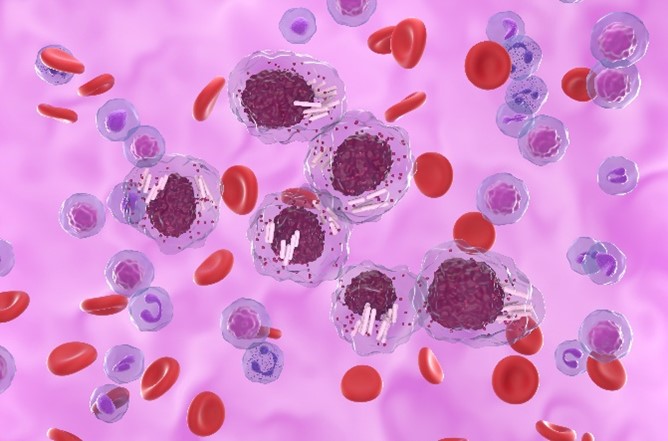What are PBMCs?
Human peripheral blood mononuclear cells (PBMCs) are isolated from peripheral blood and identified as any blood cell with a round nucleus (i.e. lymphocytes, monocytes, natural killer cells (NK cells) or dendritic cells). PBMCs are key components of the body's complex and dynamic immune system. These cells have important immunological roles defending the body from infection, cancer, and other foreign invaders, making them ideal specimens to study immunological responses.

The Cell Types in PBMCs
There are three cell types present in PBMCs: lymphocytes, monocytes, and dendritic cells. Each of these PBMC cell types is responsible for carrying out a specific function.
Lymphocytes
The majority of an enriched human PBMC sample are composed of lymphocytes — approximately 70-90%. Lymphocytes are the most abundant white blood cells (WBCs) and play an important role in responding to both diseases and infections. In a human PBMC population, lymphocytes are divided into the following categories:
Total number of T cells (CD3+) – Roughly 45-70% of the lymphocytes in the sample are naive, resting CD3+ T cells. These lymphocytes have not yet been activated through antigen recognition and travel freely through the bloodstream until needed. These cells may also include memory cells that are primed against a specific antigen and reactivated upon exposure.
CD4+ helper T cells – When CD3+ T cells are activated, they develop primarily into CD4+ or CD8+ T cells. CD4+ T cells are called helper T cells because their main function is to activate immune responses. They use receptors to bind to antigen-presenting cells (APCs) and release chemicals to indicate the location of invasive cells, marking them for elimination. Helper T cells account for 25-60% of the total number of activated CD3+ cells.
CD8+ killer T cells – Another type of differentiated T cell is called a CD8+ killer T cell. Sometimes called cytotoxic T cells, these specialized lymphocytes are responsible for producing antibodies that seek out and destroy invasive cells. About 5-30% of activated CD3+ cells are killer T cells.
B cells – Similar to T cells, most B cells exist in the bloodstream as naive or memory cells. Once activated by antigen, they differentiate into plasma cells that can target freely circulating antigens. By secreting antibodies into extracellular space, they can track down and destroy harmful cells beyond the reach of T cells. B cells make up around 5-15% of the total number of lymphocytes.
Natural killer (NK) cells – A small subset of lymphocytes, accounting for 5-10%. These cells are viewed as the human body's innate front-line defense system. NK cells carry out their roles without the need for antigen activation.
Monocytes make up a much smaller proportion of human PBMC sample than lymphocytes, approximately 10-30%. Monocytes are a subset of white blood cells that find and destroy pathogens, such as bacteria or viruses in order to stop infection. They reside within tissues and traffic throughout the body in the bloodstream until a possible pathogen activates them.
The third type of PBMC are dendritic cells. Dendritic cells are highly specialized APCs capable of completely engulfing an antigen and then presenting a small part of the same antigen to the immune system. Dendritic cells are specialized white blood cells, accounting for only 1/100 of the total PBMC composition. Though low in concentration, these cells are crucial in identifying unknown substances and communicating with lymphocytes. They possess the ability to process both internally- and externally-derived antigens on major histocompatibility complexes on their surface to alert other immune cells to the threat. They are an important component of the innate immune system but also serve an important role in the human adaptive immune response.
Table 1. Average composition of PBMCs in a healthy adult.
| Cell subset | Percentage (%) | Markers | Function |
| CD4+ T cells | 25-60% | CD3+CD4+ | Coordinate adaptive immunity through activation and regulation of other immune cells |
| CD8+ T cells | 5-30% | CD3+CD8+ | Destroy cancer cells or cells that are infected or damaged |
| B cells | 5-10% | CD19+ | Secrete antibodies as part of humoral immune response |
| NK cells | 10-30% | CD56+CD3- | Trigger lysis or apoptosis of infected cells |
| Monocytes | 5-10% | CD14+ | Take up foreign objects via phagocytosis, perform antigen presentation, and produce cytokines |
| Dendritic cells | 1-2% | Process and present antigen to T cells |
PBMCs Application
Oncology and immunotherapy
Researchers often use PMBCs to better understand immunological diseases and to develop immunotherapies. For example, PBMCs is used to study the pathogenesis of asthma and other allergic diseases involving multiple immune pathways. Additionally, PBMCs are key to manufacturing CAR-T therapies for cancer treatment. At the beginning of the CAR-T manufacturing process, scientists isolate PBMCs from patients via leukapheresis and then reprogram the isolated T cells with gene editing. This allows the T cells to identify and eliminate cancer cells that express specific target antigens.
Infectious disease and vaccine development
Many scientists employ PBMCs in infectious disease research and vaccine development. Researchers gather information about immune response by studying the frequency of specific PBMC subsets in the circulation. This would be useful for many applications, including understanding which cell types are involved in fighting different infections, examining immune response to specific antigens, and determining immune activation following vaccination.
Regenerative biology and transplant
Scientists transplant peripheral blood-derived stem cells to regenerate tissue and restore function after injury, making these cells ideal for clinical applications in regenerative medicine. Blood is the most convenient source of stem cells for patients and is also a widely available source of adult stem cells for both basic research and clinical applications. The PBMC population contains many different types of multipotent progenitor cells that can differentiate into specific cell types under appropriate conditions. Researchers can also expand PBMC populations in culture and reprogram them into induced pluripotent stem cells (iPSCs).
Creative Bioarray Relevant Recommendations
Accelerate your programs with Creative Bioarray's extensive inventory and prospective network of PBMCs.

